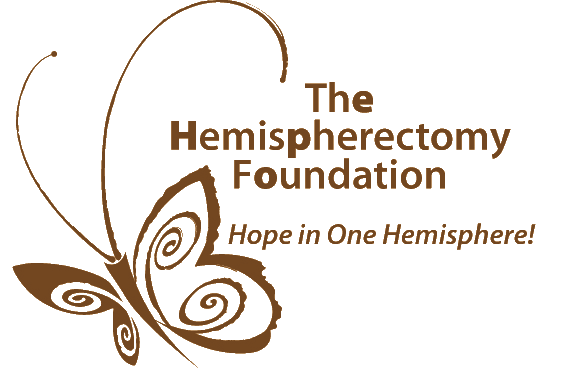Sturge-Weber Syndrome
How could a facial birthmark cause so many problems? That's what most families wonder when their child is born with what is called a Port-Wine Stain. This vascular malformation typically involves the skin, eyes, and brain and when it does so the condition is called Sturge-Weber Syndrome. The birthmark requires laser treatments, the eye/s can develop glaucoma and the brain suffers seizures due to calcification and atrophy brought on by the abnormal blood vessels. Perhaps the most frightening thing parents of a child with Sturge-Weber will ever face is a hemispherectomy-- a surgical procedure in which the diseased half of the brain is removed.
Sturge-Weber Syndrome is a congenital, non-familial disorder of unknown incidence and cause. It is characterized by a congenital facial birthmark and neurological abnormalities. Other symptoms associated with Sturge-Weber can include eye and internal organ irregularities. Each case of Sturge-Weber Syndrome is unique and exhibits the characterizing findings to varying degrees.
Facial Birthmark
The most apparent indication of Sturge-Weber Syndrome is a facial birthmark or "Port Wine Stain" present at birth and typically involving at least one upper eyelid and the forehead. Much variation in the size of the stain has been reported and may be limited to one side of the face or may involve both sides. The stain, varying from light pink to deep purple, is due to an overabundance of capillaries just beneath the surface of the involved skin. In persons with dark pigmentation, the stain may be difficult to recognize. In rare instances, there is an absence of a Port Wine Stain.
Neurological Abnormalities
Neurological concerns relate to the development of excessive blood vessel growth on the surface of the brain (angiomas). These are located typically on the back (occipital) region of the brain on the same side as the port wine stain. These angiomas create abnormal conditions for brain function in the region. Seizure activity is the most common early problem, often starting by one year of age. The convulsions usually appear on the opposite side of the body from the Port Wine Stain and vary in severity. Vigorous attempts are made to control the seizures with medication. A weakening or loss of the use of one side of the body (hemiparesis), may develop opposite to the port wine stain. Developmental delay of motor and cognitive skills may also occur to varying degrees.
Other Manifestations
Increased pressure within the eye (glaucoma) is another condition which can be present at birth or develop later. The incidence of glaucoma in patients with Sturge-Weber is approximately 70% and 40% for choroidal lesions. The glaucoma is usually restricted to the eye which has the stain involvement. Enlarging of the eye (buphthalmos) can also occur in the eye which has been affected by the stain. Multiple other body organs are rarely affected in Sturge-Weber syndrome. Infants affected with Sturge-Weber Syndrome are often monitored by a pediatrician, neurologist, ophthalmologist, and dermatologist.
Treatment
Laser treatment is available to lighten and or remove port wine stains in children as young as one month of age. Anti-convulsants are used to control the seizures. Vagus nerve stimulation (VNS) implants and brain surgery can be also be utilized for seizure management. Eye drops or oral medications are used to control the glaucoma. Should topical or oral medications not prove effective, the next step would be surgery.
What are the statistics?
SWS has no clear genetic pattern, and two affected individuals almost never arise in the same family. The syndrome presents in all races and with equal frequency in both sexes. Port wine stain birthmarks occur in 3 of 1,000 newborns.
In a patient with a facial port wine stain, the overall risk of having SWS is only about 8% to 15%. The risk of having SWS increases to 25% when half of the face, including the ophthalmic division of the trigeminal nerve is involved and rises to 33% when both sides of the face, including the ophthalmic division of the trigeminal nerve are involved.
Seizures occur in 72% to 80% of SWS patients with unilateral brain lesions and in 93% of patients with bihemispheric involvement. Seizures can begin anytime from birth to adulthood, but 75% of those with seizures begin having them during the first year of infancy, 86% by age 2, and 95% before age 5.
Glaucoma occurs in 30% to 71% of patients.
Things to watch for:
- Eye - The eye may appear to be bulging, watering, cloudy, or enlarged, especially in the eye with port-wine stain involvement.
- Seizures - There are many types of seizures, and children with SWS may present with more than one type. The seizure threshold may be lowered by cutting teeth, immunizations, illness, etc. T
- Port Wine Stain - "Angel kisses" (spots over or between eyes) and "stork bites" (back of neck) are normal, and will fade in time. A port wine stain, while it may lighten or darken will not completely disappear.
Testing/Obtaining Diagnosis
- Eye - All newborn babies with a port wine mark affecting the eyelids and/or brain involvement should see an ophthalmologist in the first few weeks of life. Children with port wine mark involving lids may be at life-long risk of glaucoma and require periodic eye examination, often under anesthesia or sedation, in the first years of life until able to be awake for testing.
- Brain - MRI with contrast, however, be advised that due to the progressive nature of SWS, brain involvement may not be evident on early scans.
- An MRI of the brain with and without gadolinium enhancement is recommended for visualization of the leptomeningeal angioma. Early in infancy the abnormal blood vessels on the surface of the brain may not be seen even by MRI. If the initial MRI is normal, it can be repeated at 2-3 years of life to exclude the presence of a leptomeningeal angioma.
- Brain calcification is most easily seen with a head CT, but this is not usually an early finding. Other typical findings on brain imaging include brain atrophy (decreased brain mass) and enlarged deep draining veins on the affected side. Angiography is NOT routinely performed in the evaluation of children with SWS, but may be required in atypical cases to evaluate for other associated vascular malformations. PET and SPECT images are not routinely indicated except when surgery for seizures is being considered. If seizures occur, then an electroencephalogram (EEG) is obtained to evaluate brain function and seizure foci.
Treatment
- Port-WIne Stain: Vascular specific laser treatment may lighten the color and decrease the size of port wine stains, but complete resolution is possible in only a minority of cases at this time. Treatment can be started as early as one week of age, depending on doctor recommendations and parent's preference. The earlier a child begins laser treatments, the more effective they will be. Treatments can be done every 6 to 8 weeks, however the number of treatments needed or the percentage of clearing depends on the stain itself, and varies greatly. The type of anesthesia used (topical or general) will be based on the preference of the family and physician.
- Seizures: When a child presents with a new-onset seizure, a neurologic consultation should be sought. Routine studies including blood glucose, electrolytes, serum calcium and magnesium and CBC should be obtained to evaluate for precipitating factors. EEG and neuroimaging studies such as CT or MRI scan of brain should also be obtained. Aggressive antiepileptic regimen should be established from the first seizure.
- Glaucoma: Medications should be initiated as first line treatment for glaucoma, and multiple medications in combinations may be necessary to lower the intraocular pressure.




